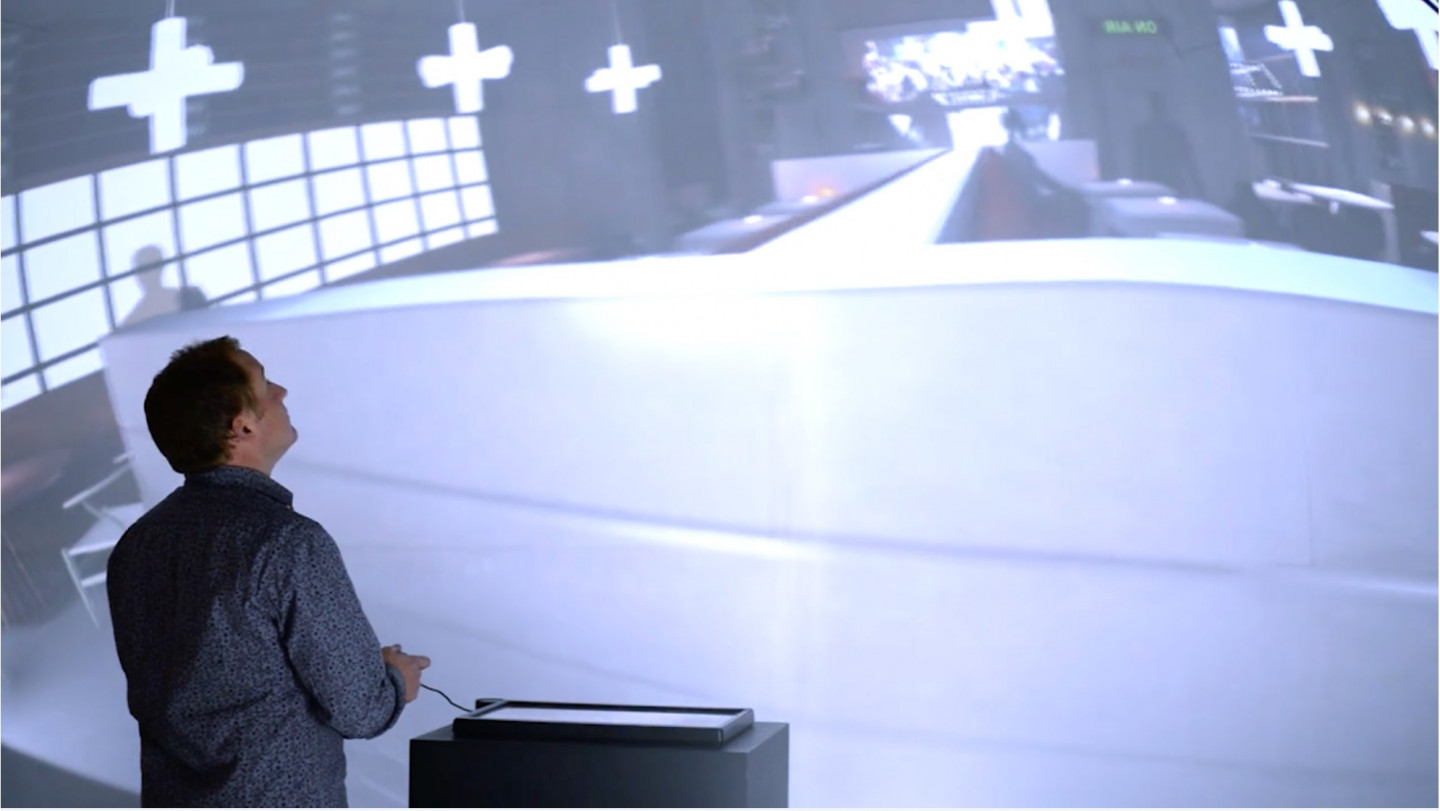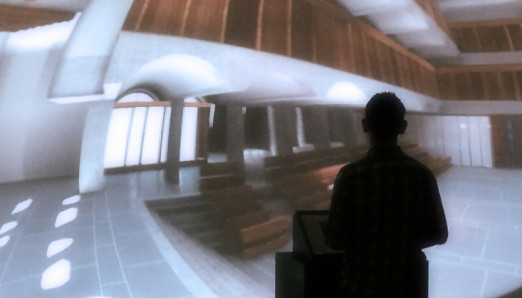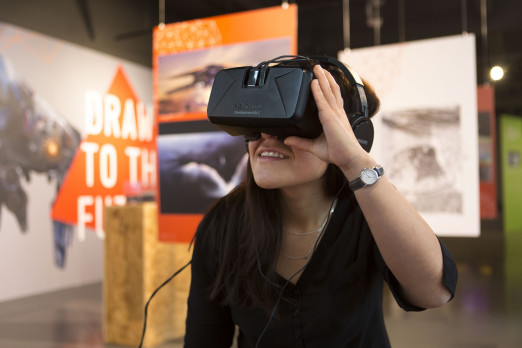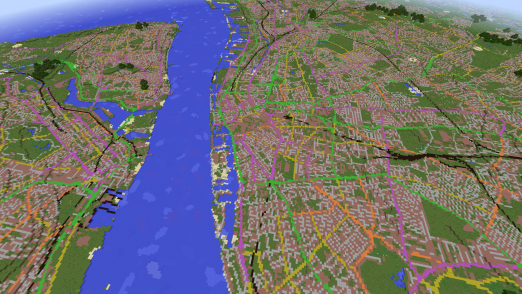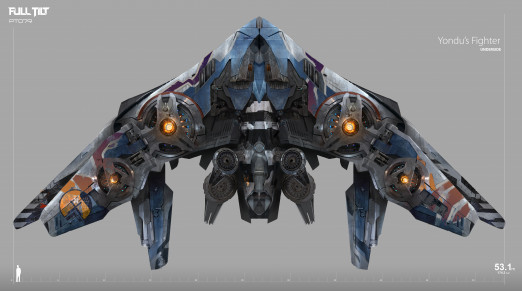Interview with Fergus Bruce of Soluis.
Where does the immersive work sit among the more traditional kinds of visualisation work you do?
Fergus Bruce, Group Communications Manager, Soluis: The immersive work we do is very much a function or logical consequence of the traditional visuals we generate.
How has this work developed since Soluis began?
Fergus Bruce: For years we were aware that once we handed over our work, we had little control over how it was engaged with, and that ultimately material that had been generated in 3D was usually played back on 2D screens. In this respect we had numerous ideas for how we might bridge that gap, and that there was an obvious continuum between our creating core 3D environments, and creating immersive software and hardware to drive our audience’s understanding of and engagement with our work.
We now deploy a ‘Single Visualisation Environment’ approach to the majority of our work, where our core visualisation material can easily be delivered through several immersive technologies. This approach has developed rapidly and now gives us the capacity to publish via a number of immersive platforms, including – of course – our dome.
Immersive media is seeing tremendous interest and growth at the moment, brought about largely by technological advances in both hardware and software but also a readiness for something new. The medium requires an entirely new attitude to content and 'experience' production. No longer confined by an image frame, we no longer consider the camera to be a camera, rather a portal to a virtual world. Many of the tricks of the trade for traditional visualisation now become redundant in favour of a more sensitive and human approach to immersive production which seeks to galvanise trust between content producer and audience.
What kinds of briefs were you given for Radisson RED, St Peter’s Seminary and Glasgow School of Art?
Fergus Bruce: Radisson RED emerged out of a constantly evolving design development process we were a key part of. We worked very closely with their design teams and created a vast amount of CGI content, which was instrumental in iteration and review of the entire design identity of the brand.
Creating human scale and immersive environments using this large CGI resource using multiple technologies was an obvious step in delivering a realistic brand experience for audiences of all kinds.
St Peter’s Seminary and the GSA Library both started out as exemplar R&D projects internally, though they have both recently come to public attention. The brief we set ourselves with both of them was no less than the complete digital restoration of two derelict or destroyed architectural masterpieces using games engine technology, and whatever design information was available.
We wanted these models to be accessible across the full range of technology platforms we work with, using the ‘Single Visualisation Environment’ workflow, and to eventually form a resource for designers, academics and the general public. We will be continuing to evolve these models over the next 12 months.
Research
Are there any studies around how people process visual information in an immersive interactive environment compared to a conventional 2D image?
Fergus Bruce: There are academic papers on the potential of VR technology to transform human learning going back to the 70’s. However it was the recent launch of Oculus’ first ‘Rift’ device in 2012 that fired the starting gun on a whole new wave of consideration and ideation. Google’s recent ‘Cardboard’ product and it’s utilitarian design is already being used in educational contexts to great effect, but the latest VR boom is still relatively new, so we are really only just peeling back the lid on what full user immersion could do for the good…
We certainly have plenty of anecdotal evidence of the positive influence of VR technology. Our recent work in creating immersive, interactive versions of the 3D modelled environments has proved beyond doubt to us that the levels of buy-in, attention and assimilation users present when engaging with immersive technology versus traditional 2D screens are notably higher. In simple terms, the more someone believes they are actually in a space (i.e. the more ‘present’ they feel in it) the greater their connection with it will be, and the more they will believe whatever narrative is presented to them regarding it.
We can say with certainty that design of form, space, structure and layout are far better served within the physical world as opposed to a 2D digital representation of it. Immersive environments are a dramatic shift towards the physical world, our immersive dome for example is not some arbitrary shape but rather one designed to replicate the form and experience of our eyes to render an image as close to 'being there' as possible.
From a design development point of view this can be critical in development and iteration, identifying problems early and removing the need for expensive physical prototypes. We are really just limited by our imaginations at the moment, so it’s an exciting time to be working in this space!
In the Radisson work you note how it is aimed at the Millenials, do this generation perceive/process information differently?
Fergus Bruce: There is also certainly a differentiation in how different demographics respond to the technology. This seems to relate roughly - though not always - to age, with younger groups like the ‘millennials’ already being well inured to smart technology, and quicker to understand what to do with it and its value. That being said, generations that haven’t grown up with easy access to these kinds of immersive technology, whilst perhaps taking longer to understand the benefits, are often the most enthusiastic respondents when they realise what it means for working practices that have often been in-place for decades.
Making
What kinds of hardware and software do you use?
Fergus Bruce: Our early work in immersive environments saw us using games controllers and high-power Desktops to create interactive models of our projects. This then evolved to large scale touchscreens, high powered tablets and then we helped ‘Kickstart’ the first Oculus device in 2012. From then we’ve worked with a range of new VR/AR wearables (e.g. Samsung GearVR, Carl Zeiss VR One, Google Cardboard…), and of course developed our own immersive dome solution as a 1:1 scale immersive platform.
What inspired the ‘Dome’ as a visualisation space?
Fergus Bruce: The dome was very much inspired by the limitations of flat screen media; of seeing through the lens of a camera rather than an eye, and by the same ‘must get our audiences inside our content’ drive that has catalysed much of our work in this regard. The key difference with the dome was that we wanted something that on the one hand 1:1 scale playback to deliver maximum levels of realism, but on the other allowed stand-up collaboration between multiple viewers without the need for networked headsets, as if they were walking through the space for real.
The Visual
How do think your immersive environments will shape our sense of history?
Fergus Bruce: Our heritage division spends its time asking itself these very questions! The key phrases here are definitely ‘digital restoration’, ‘digital preservation’ and ‘virtual tourism’. As we are currently doing with St Peter’s Seminary and the GSA Library, immersive VR technology can in a certain sense restore ruined, destroyed or lost architecture and historical structures.
Using a fusion of data collection techniques, 3D modelling and games engine technology users can get as close to experiencing digitally preserved sites and heritage assets as possible without actually being there; even if the structures involved are no longer extant or are too sensitive to allow actual tourist visits.
The potential for these ‘digital heritage’ approaches in driving learning and understanding of how places looked, people behaved and society functioned in the past – and in recording and sharing our current way of life – are enormous. This, again, is all produced by being able to ‘plant’ the user within any modelled or photographed site or space in a manner that makes the experience feel real and believable. In this context knowledge & understanding of major historical events and locations can be vastly increased.
Any unusual reactions from people and clients to the experience of the dome?
Fergus Bruce: We get all kinds of reactions to the dome, though the common theme is certainly that everyone who comes into contact with the idea can see vast potential for it, whatever their area of expertise. Architects and designers can see the possibilities for design review and refinement at full scale; engineers can see huge possibilities in exploring dangerous environments & safety protocols before committing people to the job; heritage professionals can see many of the benefits listed above; educators recognize its value as a learning and training tool…
Perhaps one of the most unusual responses was from a psychologist, who suggested VR technology like the dome could be used to help place users in someone else’s shoes, and that this could be of huge benefit in the treatment of people where empathy and understanding the perspective of others presents difficulties.
Futures
What would it take for this technology to become more mainstream?
Fergus Bruce: For VR technology in general, as ever it will be a tripartite relation between hardware manufacturers, software developers and marketers in generating sufficiently diverse use-cases, affordable technology and accessible applications in establishing a consumer market.
However, the democratisation and monetisation processes for VR/AR are already well underway. Facebook, Google and Microsoft have all entered the market in the last 2 years, and are in an arms race to develop viable, affordable consumer versions of the devices they own or have developed. The price-point for the technology is also coming down rapidly, with a Google Cardboard costing only $10, a Zeiss VR one £100, and the latest Oculus device mooted to be around the $300-$400 mark. With this being the case, VR technology itself will likely become mainstream within 3-5 years – which given that it has been around since the 1970s, is astonishing.
What are the next steps in immersive image-making?
Fergus Bruce: For Soluis, our dome is clearly a proprietary platform, but the format is easily transportable and transplantable and there is nothing in-principle to prevent it from becoming a very wide-spread tool for engaging in immersive environments, particularly in the commercial sectors in which we operate.
Good quality immersive 3D media feeds off good quality data, and the proliferation of easily accessible ‘Big Data’ can only be a boon for those seeking to innovate in how it is presented and understood to best effect using VR and AR. The future certainly holds much more Big Data, and much more diverse data sets, and this will open up huge new territories for visualisation. We’ll be making sure we are at the forefront of harnessing the value of this expansion of opportunity for all the imagery we create.
